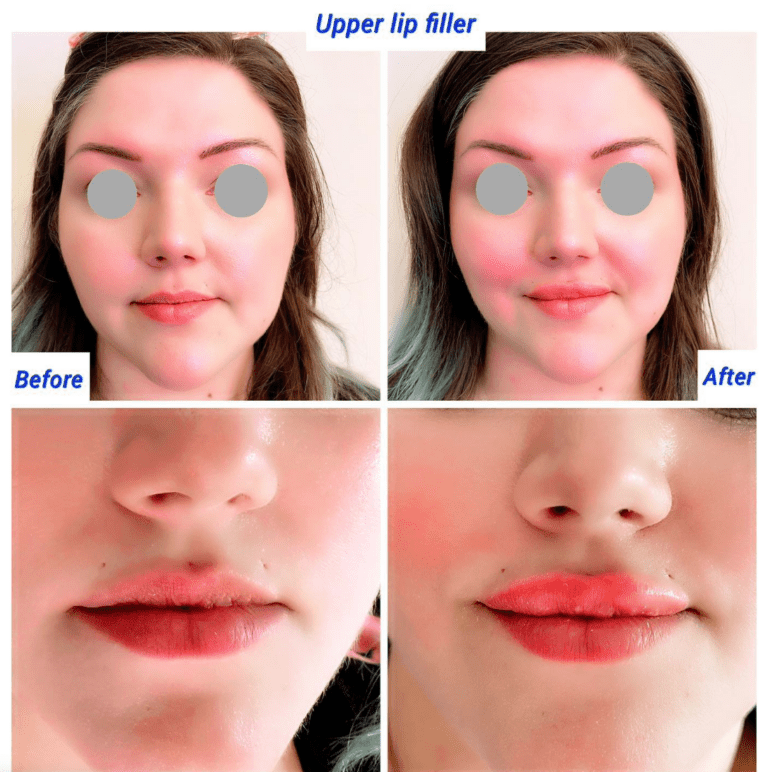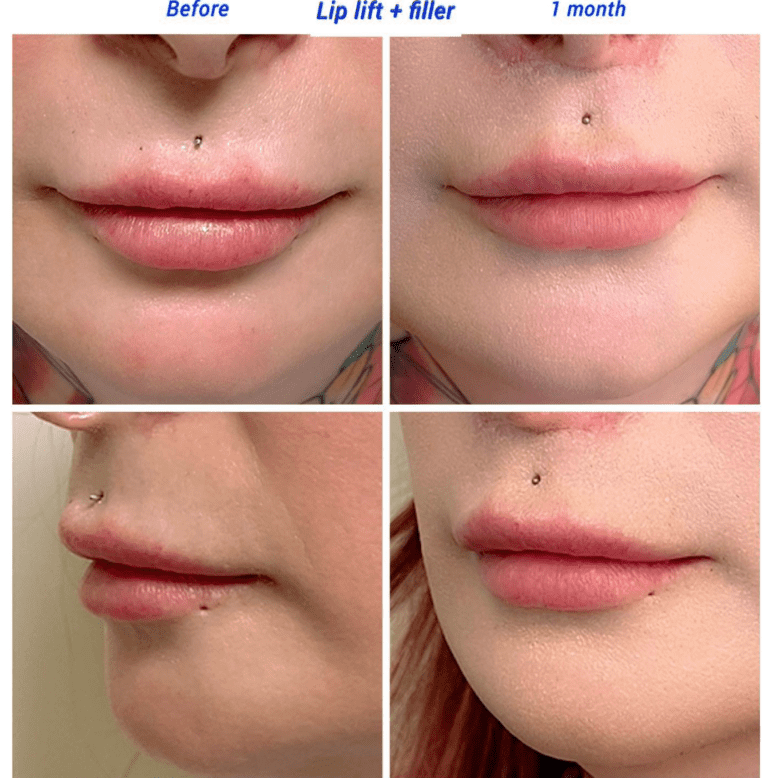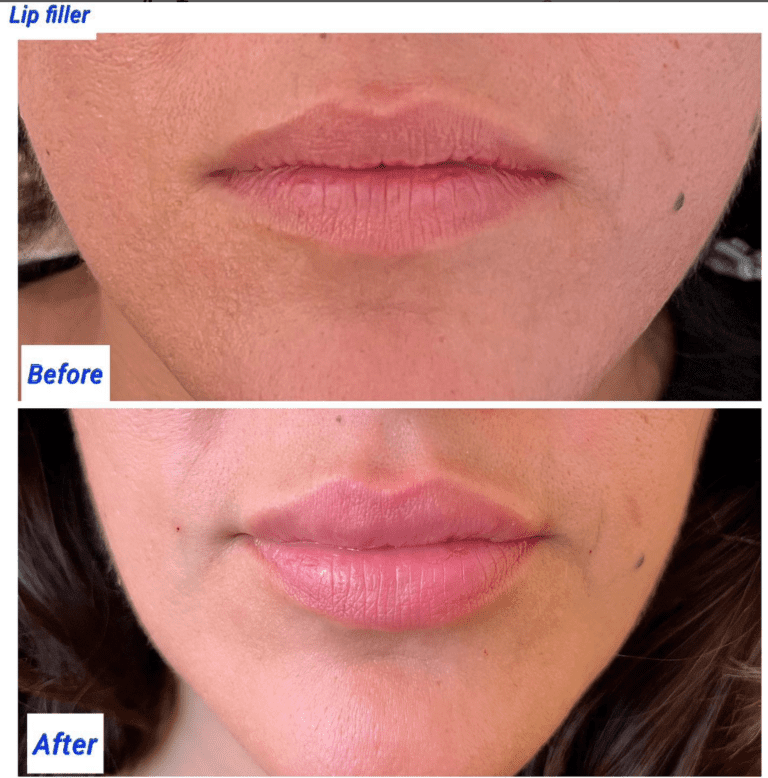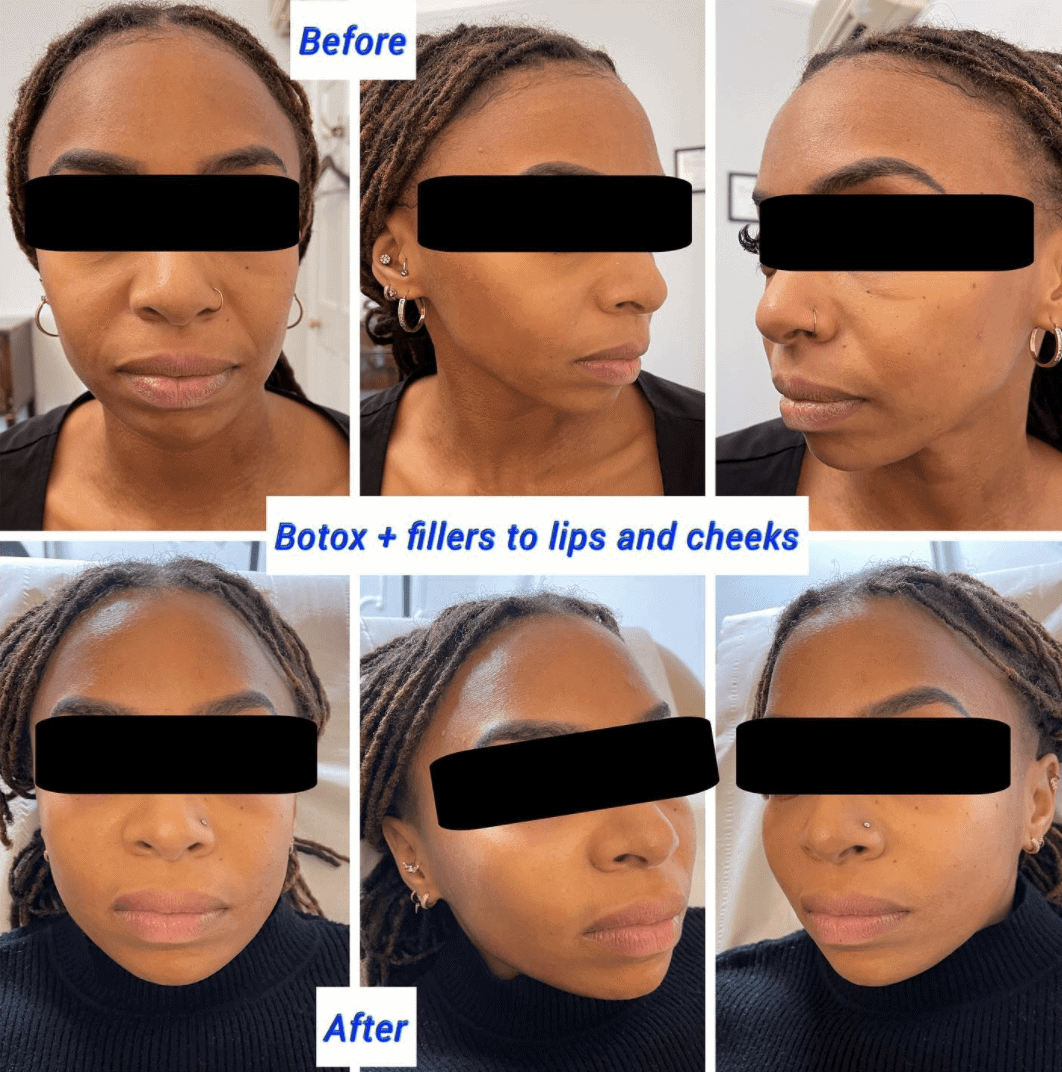There are different types of skin treatments and facial procedures that deliver varying results. From brightening the skin to adding volume to the face, it’s important that you find a procedure that’s right for you.
Botulinum Toxin, Fillers, Peels, and Microneedling: Quick Overview
- Surgery Time: 30-60 minutes
- Anaesthetic: Numbing cream
- Hospital Stay: Same-day
- Time Off Work: 0-1 week
- Exercise: up to 2 Weeks
- Mobile: Immediately
- Washing: Up to 2-3 days
- Sleeping Position: On back up to 2 weeks
- Full Recovery: 0-2 weeks
Types of Facial Treatments: Botulinum Toxin, Fillers, Peels, and Microneedling
From dry skin to redness, it’s common to experience problems with your skin. The good news is that there are several treatments that you can get to help improve your skin’s appearance as well as work on specific issues. Whether you’re looking to add volume and plump or smooth out wrinkles, here is a breakdown of 4 types of facial treatments and what they can do for your skin.
Botulinum Toxin
Botulinum toxin is actually a brand name for a type of botulinum toxin. The toxin is produced by a bacterium called Clostridium botulinum. The word ‘toxin’ makes it sound scary, but it’s perfectly safe when administered by a qualified professional. In higher amounts, botulinum toxin can be dangerous. However, only weaker, small amounts are used in botulinum toxin treatments.
Injectables such as botulinum toxin are a non-surgical way to improve your appearance. In the world of facial wrinkles and fine lines, botulinum toxin is considered the gold standard. Treatments tend to be quick and use a very small needle that feels a bit like a pinprick. As long as your injector is fully qualified and well-trained, your face should still look natural and not frozen in any way.
During a botulinum toxin treatment, a professional injects a small and controlled dose in specific areas of your choice. botulinum toxin blocks certain nerve signals that make muscles contract. It temporarily paralyses and relaxes muscles, softening unwanted wrinkles and fine lines. So, after the injection, the muscle can’t contract. This relaxing effect can last up to six months, which means you will need to book top-up appointments to maintain your look. The result of botulinum toxin remains local and doesn’t roam through your body.
After your initial consultation for your treatment, getting botulinum toxin takes only minutes. With the first injection, it takes time to act. You may be panicking that it does not have the desired effect but give it some time to kick into action. You should start to see results around seven or eight days after your first injection. At about 14 days, the results should be fully visible.
Although you often think of botulinum toxin for turning back the clock, many young patients use botulinum toxin as a way to delay lines and wrinkles forming. This is useful if you have concerns about signs of ageing developing later in life. Reducing the appearance of facial wrinkles is one of the most common treatments for botulinum toxin. Other areas for botulinum toxin treatments include:
Frown lines
Crow’s feet
Forehead creases
Downturned smile
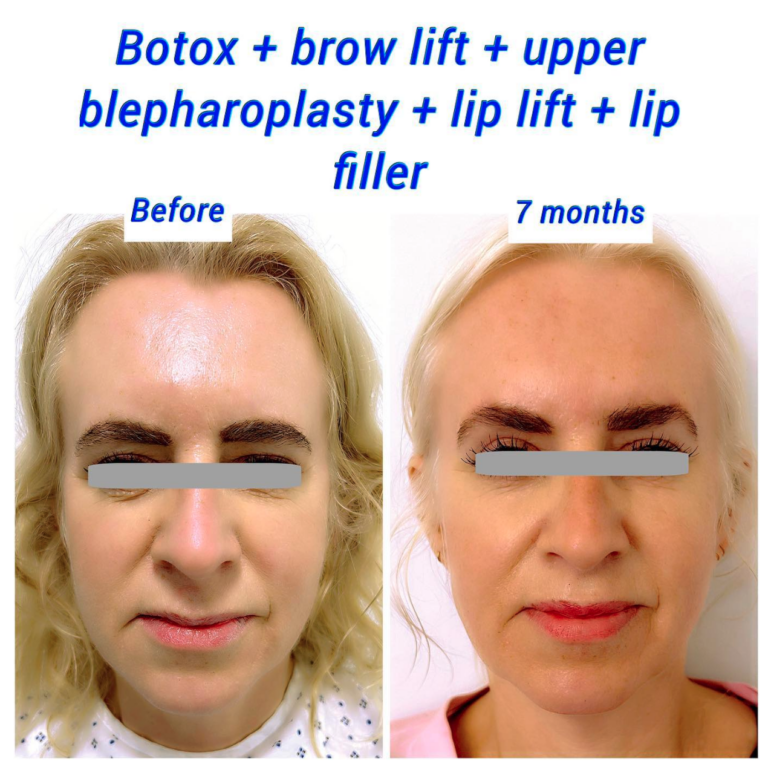
Fillers
Dermal fillers are a popular cosmetic treatment for getting plump lips, more youthful-looking skin, and even non-surgical nose jobs. Fillers are a long-lasting non-surgical way to achieve a plumper appearance. When applied by a qualified professional, they are designed to be subtle and safe. If you’re curious about fillers, here’s what you need to know before treatment.
Fillers are small injections of gel, typically containing a human-made hyaluronic acid. Hyaluronic acid is a naturally occurring substance in the skin known for its youthful, hydrating, and volume-enhancing effects. Dermal fillers add fullness to the area, such as plump up the lips or smooth away lines, wrinkles, and folds in the face. Fillers are injected into the skin to contour, revitalise and reduce unwanted wrinkles.
Traditionally, dermal fillers were mainly used to treat facial lines and creases. Nowadays, fillers can enhance a range of features like:
- Achieving a straighter nose
- defined cheeks
- Plumper lips
- Preventing chin dimples
- Smoothing out the corners of the mouth
Depending on the treatment area, fillers can last for between 6 to 18 months. Every face is unique, and the way your body reacts with the filler can differ from person to person. How long the results last will depend on the area injected and the amount of filler used. Over time, your results will gradually fade. You can opt to have ‘touch up’ appointments to maintain your look with fillers.
Lip fillers or lip injections use fillers that help to keep your lips plump for months at a time. The fillers are made of hyaluronic acid and create a plumper looking appearance.
When you come in for your lip filler treatment at Harley Clinic, the treatment itself should take around 30 minutes. If you’re looking to top up other areas at the same time, such as the cheeks, then the appointment will take longer. Before the treatment, your doctor will apply a numbing cream to the area. After a few minutes, the procedure will begin.
Lip fillers deliver immediate results within the first 48 hours and last up to about six months. We recommend follow up treatments every 6 to 12 months. You can find out more about how long lip fillers last in our quick guide.
Peels
Facials peels are a chemical solution applied to the face to stimulate the growth of new cells. Peels remove dry, dead skin, leaving a smooth and rejuvenated layer of skin. Chemical peels carefully remove the outer layer of the skin. For the best results, you would get a series of peels over a 6-12 week period. After this, you can maintain your look with peels twice a year.
A professional peel is far more potent than at-home peels as they use highly-concentrated exfoliants. You can use peels for improving acne scars, crow’s feet, sun-damaged skin, wrinkling, and sagging.
Depending on the issues that you are concerned with, you have three different options when it comes to chemical peels:
- Light chemical peel – this removes the outer layer of the skin, the epidermis. This solution is ideal for treating fine lines, wrinkles and combat uneven skin tone and dryness. You could have a light chemical skin peel every 2 to 5 weeks.
- Medium chemical peel – this type of peel removes the epidermis and dead skin cells from the upper part of the middle layer of the skin. This peel is suitable for treating wrinkles, acne scars, and uneven skin tone. Because it’s a stronger solution, you could have this peel every 3 to 9 months to maintain your look.
- Deep chemical peel – as the name suggests, the deep peel removes dead skin from the epidermis down to the lower layer of your dermis. This peel is ideal for tackling deep wrinkles, scars, or growths. You would only have this type of chemical peel once as it penetrates deeper layers of the skin and provides and more permanent result.
What is a Chemical Peel Good For?
The procedure is typically used for anti-ageing. The treatment has several benefits like:
- Improve the appearance of the skin
- Reduce age spots
- Evens out skin tone
- Smooth out skin
- Clear up breakouts
- Reduce wrinkles and fine lines
Microneedling
Microneedling really took off in the mid-90s, but innovation in the area continues to make it a hot topic today. With new technology, the minimally invasive procedure can improve the appearance of scars, boost collagen, and encourage hair growth.
Microneedling is a procedure that uses tiny needles to puncture the skin. With a handheld device, the tiny needles make small wounds that encourage your body to produce collagen. The wounds then heal, helping skin to look younger, rejuvenated, and smoother.
During a treatment session, your surgeon will use a handheld device called a SkinPen. The fine needles pierce the skin and stimulate new collagen. The punctures are more like pinpricks. They only enter the skin at surface level and are not deep at all.
The revolutionary treatment can improve and enhance skin quality. It can help treat a range of skin conditions like:
- Acne
- Scars
- Sun damage
- Stretch marks
- Fine lines and wrinkles
- Large pores
- Dark spots
The great thing about microneedling is that it’s a non-surgical treatment that’s usually less expensive than laser treatments. It also tends to work better for people with darker skin tones than laser treatments.
You can expect fairly immediate results following your treatment. In general, you would have multiple treatments spaced apart. Over time the results should improve after all the treatments. With significant breakthroughs in technology, the treatment is now more advanced and effective. Microneedling can rejuvenate your skin and treat a range of conditions.
While the results are pretty immediate, the main draw is the long-term benefits. When wound healing kicks in, it results in elastic and collagen growth. This can kickstart new layers of skin at a cellular level. In the long-term, you can expect an improvement in the appearance of wrinkles, fine lines and boost the overall texture of the skin.
Which Treatment is Best For You?
You can combine certain treatments to maximise results. It’s common to do multiple treatments at the same time as you can make the most out of the time you have and minimise your recovery period.
Many patients combine botulinum toxin and fillers in one session. The two treatments complement each other nicely by acting on wrinkles and lines in slightly different ways. botulinum toxin can help to minimise the look of crow’s feet, frown lines. Fillers can help to fill in wrinkles and creases to soften the appearance of the face.
Chemical peels, on the other hand, are stand-alone procedures. You can perform multiple treatments over separate sessions if you wanted to get botulinum toxin and a chemical peel. Your surgeon will advise you on the best way to do this. During your consultation, your surgeon will assess your skin and individual case. You may need a combination of treatments, either at the same time or in separate sessions.
How Long Does it Take to Recover From Botulinum Toxin, Fillers, Peels and Microneedling?
Botulinum Toxin
After getting botulinum toxin, you should avoid touching your face for at least 4 hours. botulinum toxin injections don’t require any downtime. You should start to see the final result in 3-5 days. You should wait until at least 2 weeks before judging the final result.
Fillers
You may experience some swelling, temporary redness, or numbness after your treatment. Most patients go back to work after their filler appointment. Fillers can take up to 2 weeks to settle in your face.
Peels
Your face can take between 7 to 14 days to heal after a medium chemical peel. Redness can continue for several months. After a deep chemical peel, you will have redness and swelling. For the majority of chemical peels, you should expect a 5-7 day recovery window.
Microneedling
You can return to work after microneedling. Usually, it takes about 24 hours to heal from your treatment, but it can take up to 2 to 3 days to fully recover, depending on your treatment.
Can You Have Botulinum Toxin and Fillers at the Same Time?
Yes, because botulinum toxin and fillers treat different areas of concerns, you can use them simultaneously. If you want to go for complete facial rejuvenation, combining these treatments may be the right solution for you.
How Long After Microneedling Can You Have Botulinum Toxin?
You can do both of these treatments at the same time. Usually, you would have microneedling followed by botulinum toxin. But if you have already had microneedling, you would wait for the skin to heal before getting botulinum toxin (3-5 days).
What are the Potential Risks and Complications of Botulinum Toxin, Fillers, Peels, and Microneedling?
Depending on the treatment or combination of treatments you get there are some potential risks and complications, including:
- Darkening or lightening of the skin
- Scarring
- Infection
- Redness
- Bruising
- Swelling
- Discomfort
- Drying
- Flaking skin
To book a consultation today, please call 0203 582 4947 or email [email protected].
Further Reading:
- How to Stay Looking Young And Refreshed: 6 Tips From a Plastic Surgeon
- Signs of Botched Cosmetic Injections and How to Avoid Them
- The 4 Most Popular Non-Surgical Cosmetic Procedures Right Now
- The 8 Top Anti-Ageing Treatments For Glowing and Youthful Skin
- Unhappy With Your Botulinum Toxin And Fillers Results? Follow These Steps
- What is a Botulinum Toxin Brow Lift?
- 4 Things Botulinum Toxin Can Do on The Face











